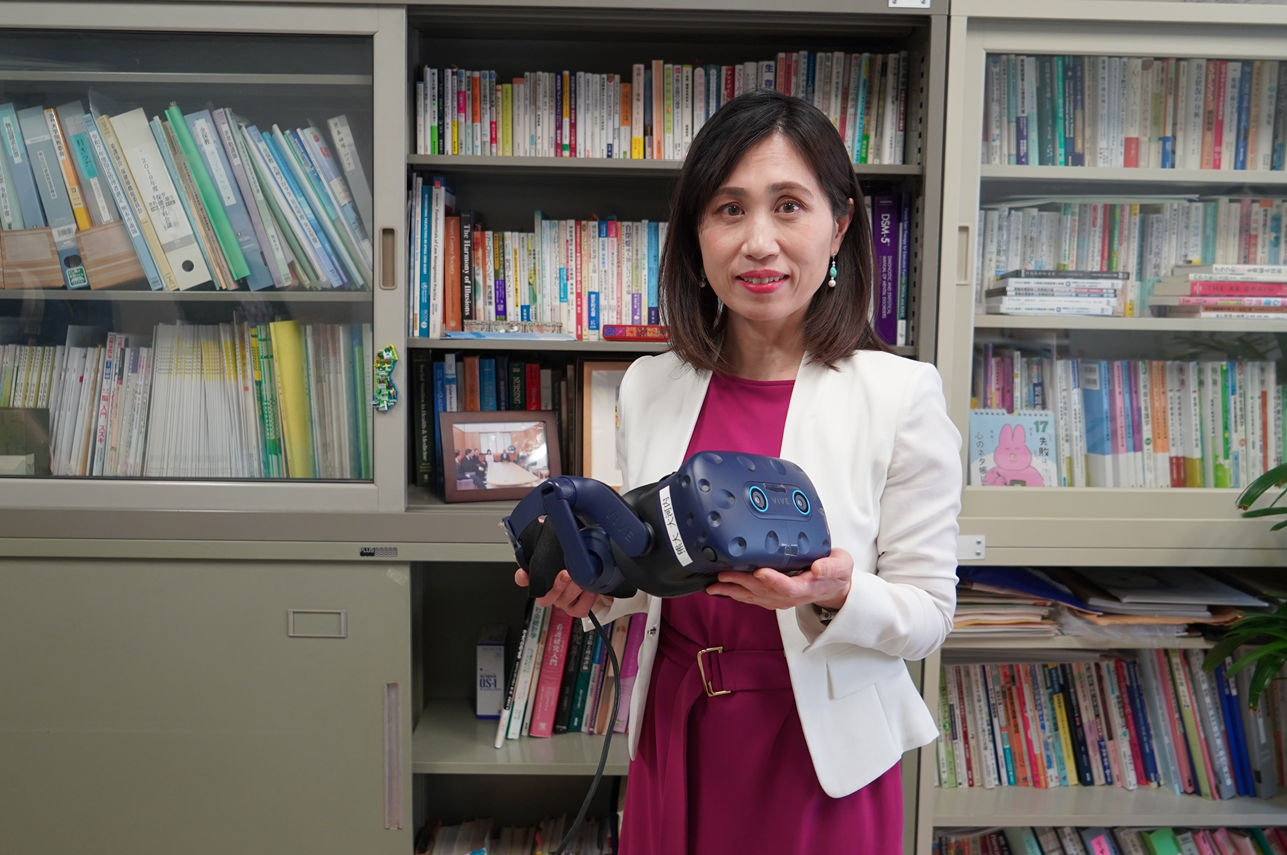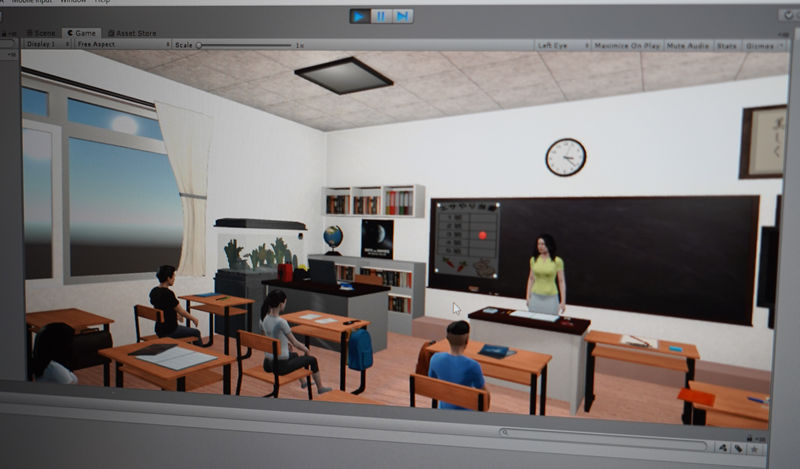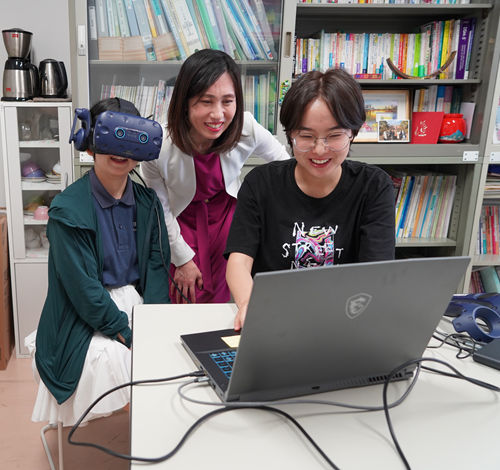Uncovering Developmental Disabilities Through Children’s Eye Movements Visualizing the Data to Enable Early Support


Prof. Ayako Ide Okochi
Professor, Department of Comprehensive Community Care Development Nursing, Nursing Department, Division of Environmental and Sociomedical Sciences, Faculty of Life Sciences
Professor Ayako Okouchi is conducting research to clarify the characteristic of children with developmental disabilities by using virtual reality (VR) goggles to measure their eye movements. Recently, research on the senses, such as sight, hearing, and touch, has been gaining attention. By converting the data into a visual format, she is aiming to promote understanding of developmental disabilities and connect children to early support.
Developing a system through collaboration between nursing and engineering
Could you tell us about your research?
I am conducting research to understand developmental disabilities in children through their eye movements. By comparing the eye movements of children with developmental disabilities to those of typically developing children, and by “visualizing” the data as much as possible, I hope to clarify the unique characteristics of their gaze patterns.This research is being carried out through “nursing-engineering collaboration,” with the cooperation of Professor Nobutomo Matsunaga from the Faculty of Advanced Science and Technology (Engineering). Together, we developed a system that displays a virtual classroom scene through VR goggles and measures, every 0.05 seconds, where children are looking. Graduate students from Professor Matsunaga’s lab also worked hard to find ways to explain the results clearly to these children’s parents.
What kind of results have you found?
Initially, I thought that children with developmental disabilities would shift their gaze frequently and look around restlessly. However, the data showed that they tended to stare intently at the teacher. This could be because we used an illustrated image of the teacher and the child liked illustrations. But I believe the issue is not that these children “lack concentration,” but rather that they “concentrate too much,” which makes them exhausted, leading others to perceive them as having poor attention.
We also set up a fish tank in the classroom and introduced auditory stimuli such as the sound of notebooks falling off desks, cats’ meowing, or a street vendor calling “Yaki-imo!” (roasted sweet potatoes). Children with developmental disabilities paid little attention to these. Yet when we conducted a quiz asking them about what the teacher had said, their accuracy rate was low. In other words, although they were looking at the teacher, the content did not register. They could focus on things they liked, but could not distribute their attention evenly. In contrast, typically developing children shifted their gaze between the teacher and the blackboard, maintaining a balanced distribution of attention.

Image: Virtual classroom as seen through VR goggles

Visualizing Sensory Patterns to Reveal Hidden Difficulties
How do parents react when you share these results?
They say, “So that’s what’s going on,” and accept the explanation. Even if parents ask teachers to be considerate, the teacher may think, “There’s no problem—the child is looking forward during class.” But looking forward does not mean the child is processing the lesson. One parent told me, “If I can show this data to the teacher, it will be easier to ask for consideration.”If a child absorbs only 20% of what others do in an hour, the remaining 80% must be supplemented elsewhere. Without intervention, academic performance may fall behind, and attending school may become distressing. I hope these findings can help schools provide accommodations and lead to early support.
It is more persuasive when you make it visible as data.
While other universities also study gaze patterns in children with developmental disabilities, I believe none have collected such detailed data as we have, thanks to the nursing–engineering collaboration.In the past, developmental disabilities were mainly associated with social or communication difficulties. Recently, however, researchers have begun to note that these children may have atypical sensory processing in vision, hearing, smell, taste, or touch. Some also have sensory modulation disorders. Developmental disabilities can be hard to detect, and even affected individuals or their parents may be unaware of the reasons behind certain difficulties. By visualizing sensory patterns, I want to make these difficulties visible. Once individuals understand their own state, they can explain it to others and more easily ask for help.

Children with developmental disabilities who have been abused tend to have dulled tactile senses.
What sensory traits do children with developmental disabilities have?
Some are hypersensitive and dislike being touched. They may arch their backs to avoid being held. Such children may calm down more when laid on a board than when held in someone’s arms. One mother told me she felt hurt when others judged her as “cold” for putting her child on a board. Because of their hypersensitivity, even getting them to sleep can be a challenge. Parents raise these children with great effort, but often face a lack of understanding from others.
With the cooperation of care facilities, we also collected data on children with developmental disabilities who had experienced abuse. While children with developmental disabilities who were not abused tended to be hypersensitive to touch, those who had been abused showed reduced sensitivity. I believe abuse forces them to numb their senses. Since some children are hypersensitive and others are under-sensitive, sensory considerations are crucial.
Listening to the voices of those affected through new technologies
Advancing research on delayed “sensations”
What inspired you to start this research?
I once developed sudden hearing loss from overwork. Immediately afterward, I became hypersensitive to sounds, feeling as if I were being attacked by noise. I finally understood the experiences of people who say they “can’t go out because it’s too noisy outside.” It’s exhausting, but not widely known. For people with auditory hypersensitivity, the starting pistol at a sports day event can be unbearable, even causing panic. That made me realize the need for more research on sensory issues.
Sensory experiences can swing both ways—hypersensitivity or hypo-sensitivity. Some people may not feel hunger clearly and can go without eating, which is dangerous. Research on sensory processing is still lagging. By visualizing sensory difficulties, I want people to better understand the challenges faced by those with developmental disabilities, so they can live more comfortably.
What are your future research plans?
I want to extend my visual perception research to develop personalized support strategies. Kumamoto University has the Special Support School attached to the Faculty of Education, so I hope to collaborate with the Faculty of Education.
Some people with developmental disabilities have difficulty speaking in person because they get nervous, but may be able to communicate freely in virtual environments using VR goggles. They might speak more openly through “avatars” they create themselves. Young people today are familiar with digital technology, so I hope to use such tools to hear their true feelings.
Is there anything you’d like the public to know about developmental disabilities?
Many people who have accomplished great things in the world have had developmental disabilities. There are many positive aspects. For example, some with auditory hypersensitivity can detect machine malfunctions by hearing subtle changes in sound, which has led to employment opportunities. I hope to create a society that recognizes these strengths and enables people with developmental disabilities to live happily.

Related links:
